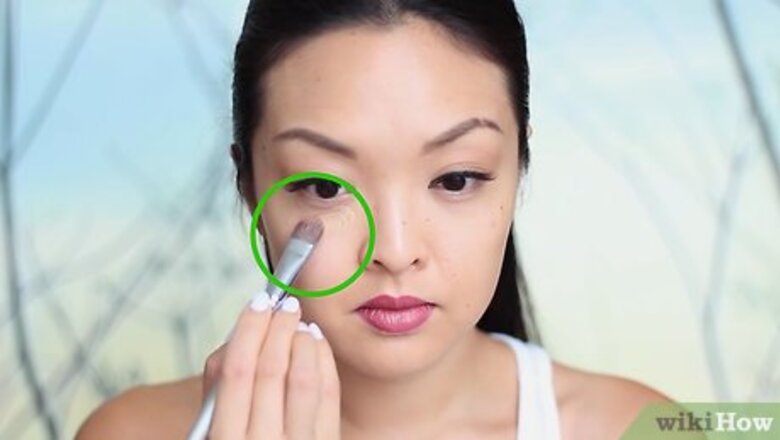
views
Applying the Base Makeup
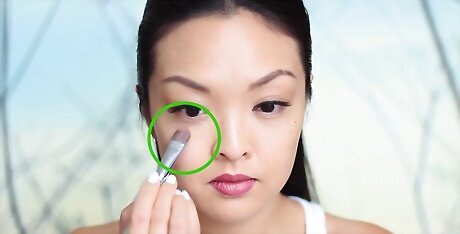
Use concealer. You will wreck your look if you’ve got dark circles under your eyes or have blemishes throughout your face. Don’t feel badly about such circles or blemishes, though. You can cover them up with concealer. Apply the concealer in an upside-down pyramid shape. You generally want concealer that matches your skin. Make sure also that your concealer matches your foundation tone. If you have dark circles, however, use a concealer with orange tones under your eye to neutralize the color. Do not use a concealer lighter than your skin tone. Instead, match the concealer to the lightest part of your face. This will look natural and brighten your complexion. Use your ring finger when you apply the concealer across your skin (or a makeup brush). The ring finger is good to use for applying makeup because it will provide a softer touch to the skin. Using your finger will help melt and blend the concealer for a flawless look.

Apply foundation. Foundation will complete the base. You should either apply tinted moisturizer or a liquid foundation. This is a different product than the primer. Use a foundation brush to apply the foundation, rather than a sponge. The brush will smooth out the application of the foundation and make it look more evenly applied on your face. It’s critically important that you find the right color foundation. You should try to match the color along your jawline. Don’t use too much foundation. You want it to even out your skin tone, not appear like a mask. Choose foundation from the yellow family if you are concerned about dark circles under your eyes. Matching the foundation color to your chest is a good way to find the right color for your face.
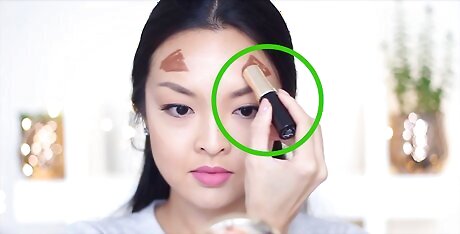
Try a foundation stick. Don’t want to put foundation all over your face because you prefer a more natural look? You could try using a foundation stick. This is also a less time-consuming way to apply base makeup. Use the stick as if it’s a giant marker. Draw thick lines down your cheekbones, on the sides of your nose, and above your eyebrows, and then blend it in. If you want to look bronzed, you could use a stick that’s a little darker, and put it in the same places over the lighter foundation. Blend both together.
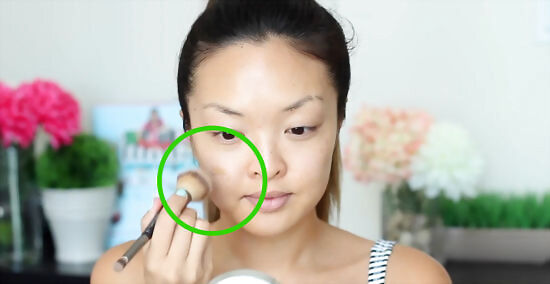
Apply powder or compact foundation. You can also use powder or compact foundation that is not in liquid form. To apply this type of foundation, you will want to use a small makeup brush. Sometimes these brushes come with the makeup, and sometimes you have to apply them separately. Hold the brush horizontally. Brush it across the powder with short strokes. Press the brush to your face in slightly rolling motions. Then, dust the powder over your face.
Completing the Base Makeup
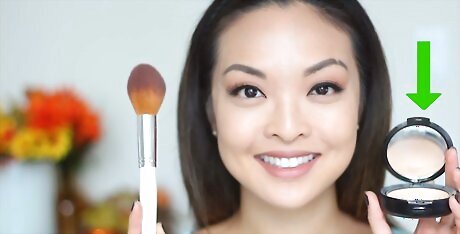
Finish the look with powder. Powder is an important step when completing base makeup because it will set the foundation and finish off the look. Set the foundation with loose powder. Buy a large powder brush to apply it. Foundation will last longer if you use powder on top of it. Use translucent powder. It will control shine and provide a matte finish to your face. It's not designed to add color, but rather to set your makeup. Make sure you dust areas of your face that get very oily. Do this first, especially in the T-zone. Then, dust the powder throughout the rest of your face.
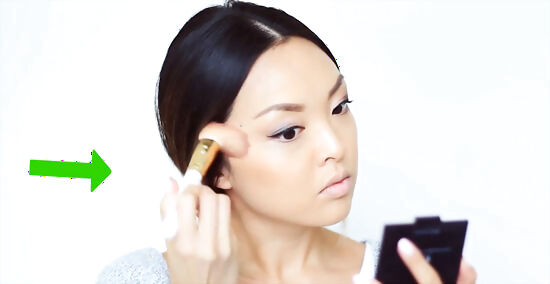
Apply bronzer or blush. Now that you’ve got the base makeup down, you should apply blush or bronzer in order to highlight your cheekbones. Put bronzer on your face, your neck, and your chest. This will even out the tone of your skin. Make sure to use a brush, and make sure the bronzer is blended. Smile before applying blusher. Then start by applying the blush on the apple of your cheek. Blend it back towards the top of your ear, and then brush it down toward your jawline. Blend it in so it doesn’t look too stark.
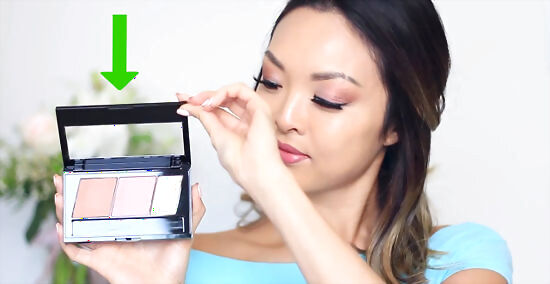
Try contouring. Contouring is a makeup trick used by many movie stars in order to alter the shape of their faces. The first step to contouring is to create a sound base using the steps above. Then, suck your cheeks in, and sweep bronzing powder on the hollows of your cheekbones. Now, take cream highlighter. Apply it above the bronzer. Make sure that you blend the cream in. Use stick foundations. With a darker one, trace your temples and carry it up to your hairline. To make your cheekbones stand out, place the pigment right above the cheekbones. For the nose, you can apply the stick on either side, either narrower at the top or carry it to the brow. Take a sponge and blend the contouring makeup into your base makeup. Now take the lighter stick, and apply it underneath your eyes. You could put some in the center of your forehead, on your chin, and on the bridge of your nose too. Dust the face with lose powder.
Starting to Apply the Base Makeup
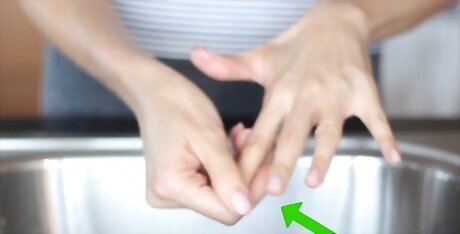
Clean your face and hands. This is really important. Before you apply base makeup, you will want to start with a fresh palette. Don’t forget to clean your hands, though, in addition to your face. Use a cleanser so you aren’t treating your face to harsh chemicals or soaps. Makeup remover or wipes can do a great job. After you clean your face and hands, apply moisturizer to your face, and make sure that it contains SPF! Wearing daily SPF is the best way to make sure your skin is protected and looks good.
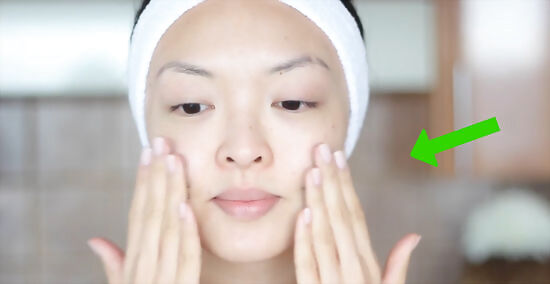
Exfoliate your face to prep it. By exfoliating your face, you remove dry skin from it. This evens out your skin tone, and it makes your skin look healthier and glowing. After you've cleaned your face with your regular cleanser, you are ready to exfoliate it. You should do this process about twice a week. Mix three tablespoons of white sugar with a tablespoon of water for a homemade technique (you can also buy exfoliating scrubs at the store). Put some of the paste on a washcloth, and gently rub it all over your face in small circular motions. Then, rinse it off.

Apply a primer to your face. Primer is a really good way to prep your skin and to make it look smoother and more flawless. You can get it at many department store makeup counters. Think of primer as a much lighter foundation. You shouldn’t be able to tell it’s there. It provides the foundation for the rest of your makeup, and will make it last longer and be less likely to smudge. Make sure that you apply it evenly throughout your face, including underneath your eyes. Don’t choose primer that’s dramatically darker than your skin. You can buy primer for different skin types, including oily, dry and combination skin. When choosing the color of your primer, understand that different colors correct different issues. Yellow and green-based primers are designed to stop redness. Pink-based primers add life to dull skin. Peach and salmon primers are good if you have darker patches or circles under your eyes.



















Comments
0 comment